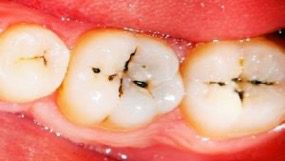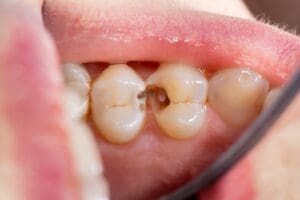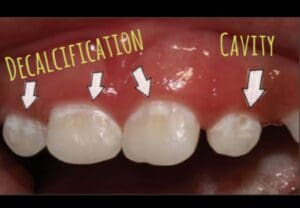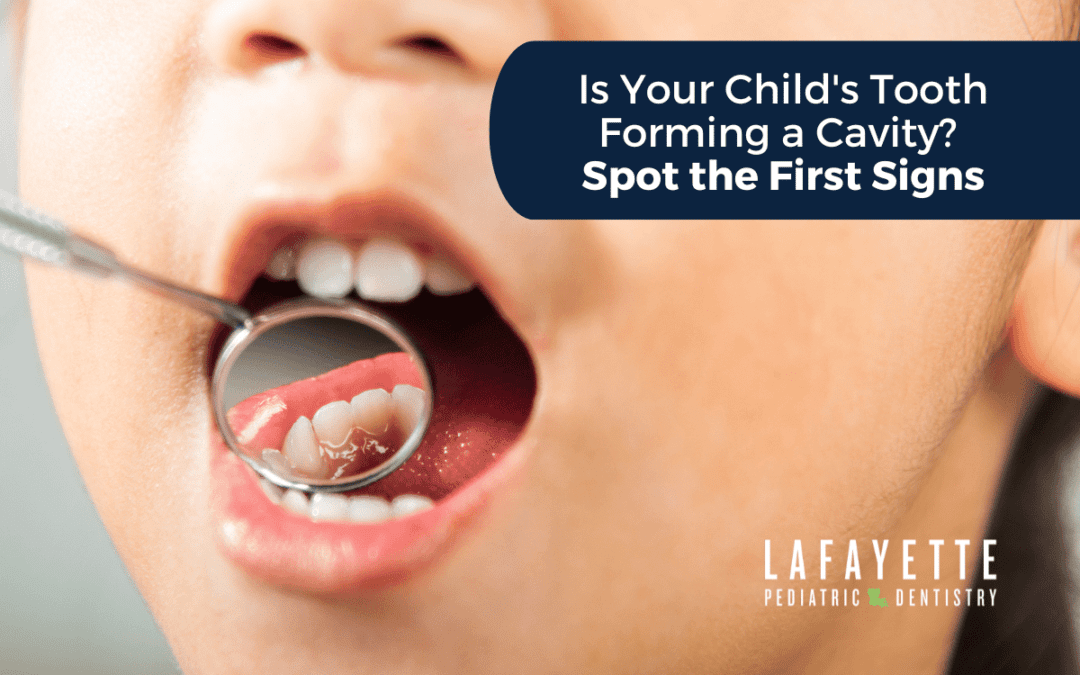Parents are always on the lookout for any signs that something might be off with your little one’s health. When it comes to their teeth, cavities are a common concern. In fact, they’re the most common chronic disease in kids across the US.
While regular dental check-ups are crucial for catching cavities early, there are some telltale signs you can look out for at home too.
Recently, our pediatric dentist, Dr. Clause, shared some valuable insights on our Facebook page about the first signs of cavities to be aware of. And in this post, we’re breaking down these key indicators.
The sooner you get your children’s teeth checked and treated, the better the chances of avoiding more extensive (and expensive) procedures for them in the future.
First Signs of a Cavity
Here are the top symptoms to stay alert for:
Teeth That Trap Food
Notice your kid’s teeth seem to be magnets for catching stray bits of food lately? That could be one of the first signs that a cavity is forming. Those trapped particles aren’t just annoying – they’re a red flag that there’s a small cavity developing on the tooth surface for bacteria to fester.
Holes, Craters, or Dark Spots
You’ll also want to keep an eye out for any unusual pits, craters, or shadowed areas on your child’s teeth. Cavities actually start as tiny holes that keep getting bigger and deeper over time. Catching those dark spots or discolored areas early is key.
Tooth Sensitivity
Another common sign of a cavity in kids? Tooth sensitivity, especially when eating something sweet, hot, or cold. If your little one’s been complaining about mouth discomfort or flinching at certain foods, it could mean decay is setting in.
Tooth Pain
Of course, good old-fashioned tooth pain is one of the most obvious cavity symptoms of all. But kids don’t always communicate their discomfort, so keep an eye out for signs like fussing while eating, avoiding chewing on one side, flinching during tooth brushing, or even bad breath as a signal that something’s up.
The earlier you can identify any of these red flag signs, the sooner you can get your child the treatment they need to nip that cavity in the bud.
Prime Spots for Cavities in Kids’ Mouths
You know cavities are a risk, but do you know where they’re most likely to strike in your child’s mouth? While tooth decay can happen pretty much anywhere, there are a few key areas that deserve some extra vigilance:
Molar Pits and Grooves
Those back molars have all kinds of deep pits, grooves, and fissures on the biting surface of the teeth – perfect little hidey-holes for cavity-causing bacteria and food particles to get trapped. Make sure your kid is brushing all the way to the back of their mouth, really getting into those crevices.
Talk to your pediatric dentist about getting dental sealants for your kid.
Sealants help prevent cavities by almost 80%, by forming a smooth barrier over those tricky grooves and pits, eliminating food and bacteria traps.
Between the Teeth
The tight spaces where teeth fit snugly together are another cavity hotspot, especially if your child isn’t flossing regularly. Don’t skip the floss!
Along the Gum Lines

Another area to keep an eye on? The gum lines of your child’s teeth. White, chalky spots around the gums could signal early decay forming. Remind your kiddo to give those gum lines a little extra brushing love too.
We recommend brushing in a circular motion, instead of just side-to-side or back-and-forth, to allow for thorough cleaning of the whole tooth surface as well as the edges of the gums.
Stay Vigilant, But Don’t Go It Alone
By now, you’ve got the lowdown on what to keep an eye out for when it comes to those first telltale signs of cavities forming in your child’s mouth.
However, cavities can be tricky customers sometimes. Even if everything looks good to you, there could be decay quietly taking hold in areas you can’t see, like between teeth or in those tight spaces. Oftentimes, X-rays are needed to catch cavities in their sneakiest, earliest stages before they escalate.
Since cavities are not always visible, and certain signs may not always indicate cavities, it is essential to take your child for regular dental visits to ensure their oral health is properly monitored and maintained.
Read Also: The 5 Most Common Causes of Cavities in Children
If you’re looking for a top-notch pediatric dental team in the Lafayette, Broussard, Breaux Bridge, Carencro, or Youngsville areas, our office is here for you.
We’re passionate about preventing cavities and educating parents on keeping those little smiles healthy for life. You can also check out our previous blog post on keeping your child’s teeth cavity-free.
Want even more kid-friendly dental tips straight from our specialists? Be sure to follow our Facebook page! Your child’s dental health is our top priority, and we’re just a call or click away whenever you need us!
